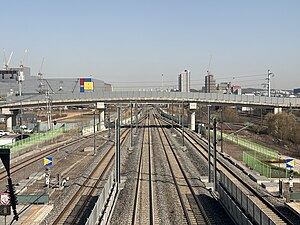

| Suseo–Pyeongtaek high-speed railway | |||
|---|---|---|---|

Tracks at PyeongtaekJije Station
| |||
| Overview | |||
| Other name(s) | Suseo HSR | ||
| Status | Operational | ||
| Owner | Korea Rail Network Authority | ||
| Line number | 103 (Korea Rail Network Authority) | ||
| Locale | South Korea | ||
| Termini |
| ||
| Stations | 3 | ||
| Service | |||
| Type | High-speed rail | ||
| Operator(s) | SR Corporation | ||
| Rolling stock |
| ||
| History | |||
| Opened | 9 December 2016 (2016-12-09) | ||
| Technical | |||
| Line length | 61.1 km (38.0 mi)[a] | ||
| Track gauge | 1,435 mm (4 ft 8+1⁄2 in) standard gauge | ||
| Electrification | 25 kV/60 Hz overhead catenary | ||
| Operating speed | 305 km/h (190 mph) | ||
| Korean name | |||
| Hangul | |||
| Hanja | |||
| Revised Romanization | Suseo Pyeongtaek Gosokseon | ||
| McCune–Reischauer | Susŏ P'yŏngt'aek Kosoksŏn | ||
| |||
The Suseo–Pyeongtaek high-speed railway (formerly known as Sudogwon HSR Line),[1] also known as Suseo–Pyeongtaek HSR, is a high-speed rail line from Suseo station in southeast Seoul to a junction with the existing Gyeongbu high-speed railway in South Korea. The line was built to ensure southeast Seoul (or Gangnam area) and southern Gyeonggi-do have high-speed rail connections.
While South Korea's first high-speed line, the Gyeongbu high-speed railway (Gyeongbu HSR) was in construction between Seoul and Busan, the government considered a second line from Seoul to Mokpo, the Honam high-speed railway (Honam HSR). The first feasibility study in 2003 came to the conclusion that the construction of a full line is not justified by demand, and proposed a two-stage construction.[2] The first stage, to be realised by 2015, would involve two branches from the Gyeongbu HSR, one of which would lead to a second Seoul terminus at Suseo in the southeast part of the city.[2] However, in plans made official in August 2006,[3] the Suseo branch was no longer included.[2]
The Suseo branch was re-launched as a separate project, the Metropolitan Area high-speed railway (initially the Suseo high-speed railway), on June 1, 2008, to improve traffic connections to two new housing development areas situated along the line in Dongtan.[4]
Preliminary plans foresaw a 60.7 km (37.7 mi) long line from Suseo to the junction with the Gyeongbu HSR near Pyeongtaek, and three new KTX stations at Suseo, Dongtan and Pyeongtaek, with the last one situated after the junction on the Gyeongbu HSR.[4] The line was to run in a tunnel at a depth of 50 m (160 ft) between Suseo and Dongtan, and construction with a budget of 4.18 trillion South Korean won was foreseen to be complete in 2015.[4] The travel time from Suseo to Dongtan was foreseen to be 12 minutes.[4] The target date for finishing the line was later moved ahead to 2014.[5]
The basic design was completed on April 28, 2010.[6] The planned length of the line changed to 61.1 km (38.0 mi), and planned stations reduced to two, at Suseo and Dongtan.[6] The government set out a timeplan, according to which detailed design was to commence immediately, and construction was to take place from the second half of 2011 until the end of 2014.[7] The first detailed design contracts were awarded in September 2010.[8]
Once the line is completed, the expected travel time will be 1 hour 59 minutes from Suseo to Busan via the Gyeongbu HSR, and 1 hour 49 minutes from Suseo to Mokpo via the Honam HSR.[8]
On September 1, 2010, the South Korean government announced a strategic plan to reduce travel times from Seoul to 95% of the country to under two hours by 2020.[9] As part of the plan, tracks for up to 230 km/h (143 mph) are to connect Suseo and Yongsan in central Seoul.[9]
In November 2020, MOLIT announced extension of Suseo–Pyeongtaek high-speed railway to Uijeongbu. However, no completion date for the extension was announced.[10]
| Station | Station distance | Line distance | Transfers | Location | |||
|---|---|---|---|---|---|---|---|
| English | Hangul | Hanja | km | ||||
| Suseo | 수서 | 水西 | — | 0.2 |
|
Seoul | Gangnam-gu |
| Dongtan | 동탄 | 東灘 | 32.4 | 32.6 | — | Gyeonggi-do | Hwaseong-si |
| PyeongtaekJije | 평택지제 | 平澤芝制 | 21.0 | 53.6 | Pyeongtaek-si | ||
| ↓ Through-service to/from Busan/Mokpo via Gyeongbu HSR/Honam HSR ↓ | |||||||
The Suseo–Pyeongtaek high-speed railway is currently utilized by Super Rapid Train (SRT) high-speed rail service.[12]
|
SRT lines and services
| ||||||
|---|---|---|---|---|---|---|
| Infrastructure |
| |||||
| SRT services |
| |||||
|
| |||||||||||||||||
|---|---|---|---|---|---|---|---|---|---|---|---|---|---|---|---|---|---|
| Railways |
| ||||||||||||||||
| Roads |
| ||||||||||||||||
| Buses |
| ||||||||||||||||
| Airports |
| ||||||||||||||||
| Related topics |
| ||||||||||||||||
|
| |||||||||||||||||||||||||||||
|---|---|---|---|---|---|---|---|---|---|---|---|---|---|---|---|---|---|---|---|---|---|---|---|---|---|---|---|---|---|
| |||||||||||||||||||||||||||||
| Africa |
| ||||||||||||||||||||||||||||
| Asia |
| ||||||||||||||||||||||||||||
| Europe |
| ||||||||||||||||||||||||||||
| North America |
| ||||||||||||||||||||||||||||
| Oceania | None | ||||||||||||||||||||||||||||
| South America | None
| ||||||||||||||||||||||||||||
* An asterisk indicates overlap with conventional services. | |||||||||||||||||||||||||||||